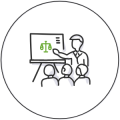Curriculum
How have landmark Supreme Court of Canada decisions impacted the lives of Indigenous peoples?
- I can name three landmark Supreme Court of Canada decisions regarding Indigenous land rights.
- I can explain what makes the cases significant.
- I can imagine the impact of these cases on future generations.
How are youth offenders treated differently than adult offenders?
- Students can collaborate effectively with others to deliver and present knowledge about the Youth Criminal Justice Act.
- Students can challenge assumptions and reflect on views on youth offenders from throughout the learning experience.
- Students can demonstrate empathy, personal responsibility, and listening skills during the restorative justice circle activity.
How are the rights of the accused upheld during trial procedures in accordance with the Canadian Charter of Rights and Freedoms?
- I can identify the legal rights in the Canadian Charter of Rights and Freedoms and discuss their importance.
- I can present examples of how Canadian Charter of Rights and Freedoms protects the rights of accused persons.
- I can reflect on my own misconceptions and biases regarding the rights and treatment of accused persons in court.
How have principles of law and justice changed over time and how do they differ today in different legal systems?
- I can debate the merits of different legal systems by using persuasive language and examples.
- I can analyze early legal systems to identify key principles and commonalities.
- I can collaborate to construct a comprehensive argument.
How are appeals determined and how can appeals lead to changes in precedent?
- I can communicate and collaborate with my peers to review the process of appeals in Supreme Court of Canada cases.
- I can critically analyze Supreme Court decisions and identify their implications for the Canadian public.
- I can take responsibility for my role in researching and sharing information to my group.
In what ways do international organizations and international law affect global change?
- I can effectively use presentation skills to communicate and analyze the role of global dispute resolution agencies in international human rights and economic development issues.
- I can evaluate facts, identify critical questions, and challenge assumptions and ideas to draw conclusions about the role and impact of global dispute agencies and courts.
- I can employ social awareness and responsibility by engaging in respectful discussion and exchanging ideas with my peers.
How does the Indian Act promote assimilation?
- I can describe the worldview of the Canadian government that resulted in the Indian Act
- I can analyze three main sections of the Indian Act: the reserve system, residential schools, and Indian status.
- I can recognize the long-term consequences of assimilationist policies and legislation on the First Peoples of Canada
How has the legal system and its laws been used to maintain inequalities?
- I can identify and discuss examples of past discriminatory laws in Canada and how they reinforced inequalities for the targeted group.
- I can analyze the legacy of discriminatory laws, for the communities previously targeted, and for Canadian society.
- I can explain how changing social values and community awareness influence the reform process of laws.
How do we balance principles of rehabilitation, punishment, and restorative justice in Canada’s Correctional System?
- Students can identify and communicate informed opinions regarding underlying principles of the corrections systems in Canada.
- Students can consider different factors involved in successful sentencing, release and reintegration in Canada’s correctional system.
- Students can explain how restorative justice helps offenders understand the consequences of their actions and develop empathy towards those affected by their actions.








